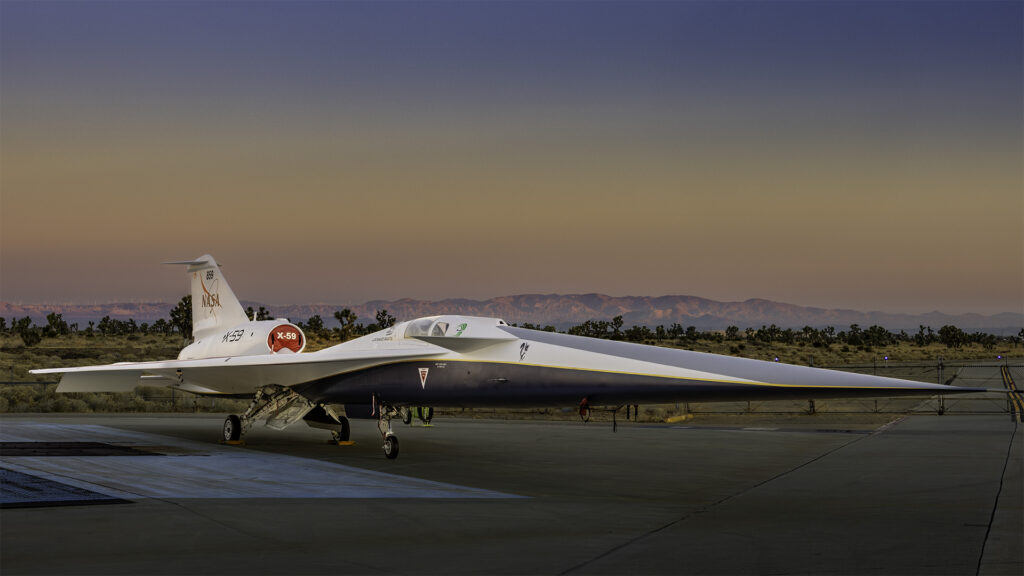NASA has officially unveiled the prototype of its strikingly elongated X-59 aircraft. Acting Administrator Robert Pearce hailed it as a “nearly 100-foot step forward” toward quiet supersonic travel over populated areas.
Scheduled to start test flights in 2024, the US space agency hopes data gathered by the plane, nicknamed “Quesst,” will help convince aviation regulators that faster-than-sound commercial flight need not mean louder-than-thunder transit for communities on the ground.
The pursuit of new supersonic tech reflects the public’s fascination with extreme speed and frustration with current aviation limitations. Travellers once enthralled by iconic “Concordes” zipping luxuriously across oceans at 60,000 feet are today resigned to flying in aircraft exceeding 550 miles per hour, no matter how far the destination.
Yet the economic and social barriers to enabling another leap in air transit velocity remain steep. When an aircraft punches through the sound barrier, tailored aerodynamics are required to manage the physics of dramatic drag increase and air pressure instability. MIT research indicates that the power needed to overcome wave drag rises by over 60% in that critical transit between high subsonic to supersonic velocities. This increases fuel consumption even as sustainable technologies and policies nudge aviation toward decarbonization.
Sonic booms present further obstacles. The US Federal Aviation Administration prohibits civil aircraft from going supersonic, defined as above Mach 1 or 767 mph, over land or coastal waters due to intense disturbance from thunder-like nose pressure shocks. Rather than inspiration, the words “sonic boom” conjure costs in environmental impact assessments, damping dreams of three-hour transatlantic runs connecting New York and London.
Quesst’s engineering team claim its plane will demonstrate a greener way forward for speedier skies, pointedly marketing its “thump” as similar to a car door closing. So how did NASA engineers behind this demonstrator aircraft tackle the economic and noise barriers to travelling at the sharpest edge of the sound barrier?
Shaping Up to Tame Sonic Booms
Quesst’s design represents nearly a decade of NASA wind tunnel and simulation testing under its Commercial Supersonic Technology Project, with insights from Lockheed Martin’s parallel work for quiet supersonic prototypes.

The X-59 model builds on a moderator known as a long-low-long/low-boom flight demonstrator (LBFD) configuration. By sculpting aircraft contours to retain sonic shockwaves longer and prevent abrupt pressure rises, LBFD shaping aims to mute thunder below the level of neighbour annoyance.
What does LBFD mean?
LBFD stands for “long-low-long/low-boom flight demonstrator” and refers to a specialized aircraft shaping configuration that aerospace engineers have developed to reduce the intensity of sonic booms.
The “long-low-long” portion describes the contour profile they try to achieve along the length of the aircraft:
- Long forebody: An unusually elongated, gently tapered nose designed to attenuate the initial sonic boom shock strength as the plane nears supersonic flight. This is evident in the X-59’s 30-meter-long narrow nosecone shape.
- Low midbody: Concentrating the bulk of an aircraft’s mass, wings, engines, etc., in the centre helps prevent intensifying the sonic shock waves. The X-59 continues this principle.
- Long afterbody: A sufficiently long rear fuselage is needed to allow the propagated shockwaves to dissipate their energy gently and not re-merge to sharp peaks.
By sculpting planes to retain these shockwaves for longer through all phases – initial impact, propagation over the length, and finally, the gradual release of pressure at the tail -LBFD shaping provides an engineering means to minimize the loudness of sonic booms heard on the ground below.
The X-59 prototype applies this mitigation method further than past test planes, with additional adaptations all intended to make shock wave propagation smooth, stable and quiet.
Its 30-meter airframe stretches this aerodynamic attenuation approach even further. Its highly elongated nose tapering gently to a narrow tip reduces initial air shock strength as the aircraft closes on Mach 1. The cockpit’s significantly aft positioning concentrates weight amidships, easing the sonic boom rise. Smoothed contours minimize drag while reducing the number of shock waves that could re-coalesce. Wing and stabilizer shaping prevent inadvertently magnifying remaining signature wave amplification.
NASA has pointed to combined CFD modelling indicating a 75 PLdB perceived loudness level on the ground for a sustained 930 mph cruise, equivalent to the FAA threshold of acceptability for a new commercial supersonic plane. Data gathering test points over communities in 2025 will determine whether public reception confirms this laboratory analysis.
Pioneering Sustainable Speed
NASA’s Quesst effort remains focused on securing regulatory permission for commercial supersonic flight over land. The associated aviation rule change would remove longstanding barriers to sustainable speed in passenger and priority cargo markets.
For example, flights connecting California and Sydney could shrink from 15 hours on today’s Airbus A350s to under 6 should future variants sustain Mach 1.6 speeds over continental routes. Similar time savings in national markets would recast concepts of distance, making once-remote locations more economically viable targets for manufacturing plants or company headquarters. NASA acknowledges supersonic transports must balance public benefit against any sustainability tipping point from increased frequency and range.
If Quesst delivers on critical metrics of greener power and gentler sonic footprint required for overland transit during upcoming test campaigns, exciting days may await upgraded successors to Concorde.
TLDR:
- NASA revealed its X-59 prototype aircraft designed to fly just under supersonic speed with a quieter sonic boom
- If regulators approve, the uniquely shaped jet with a 30-meter-long fuselage could enable faster air travel.
- NASA will test-fly the X-59 over US towns in 2025 to gather community feedback on the acceptability of the “sonic thump.”
- Key project goals are demonstrating that this new class of quiet supersonic flight is sustainable without steep noise or emissions.
- If the X-59 validates its green credentials, it may convince authorities to repeal bans on supersonic travel over land.







